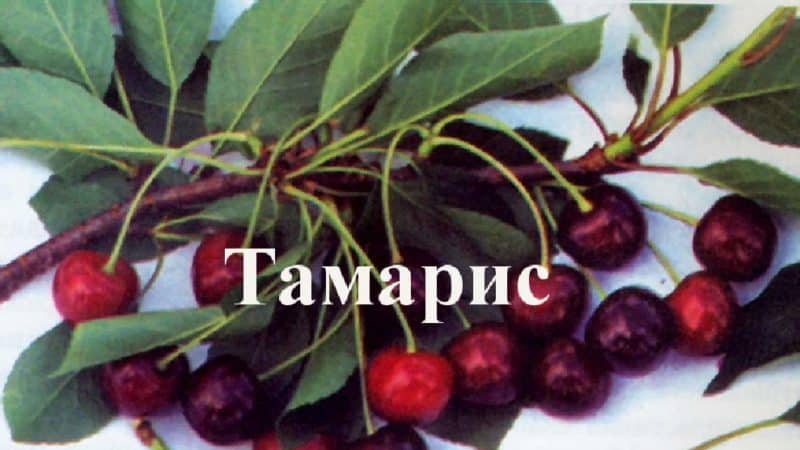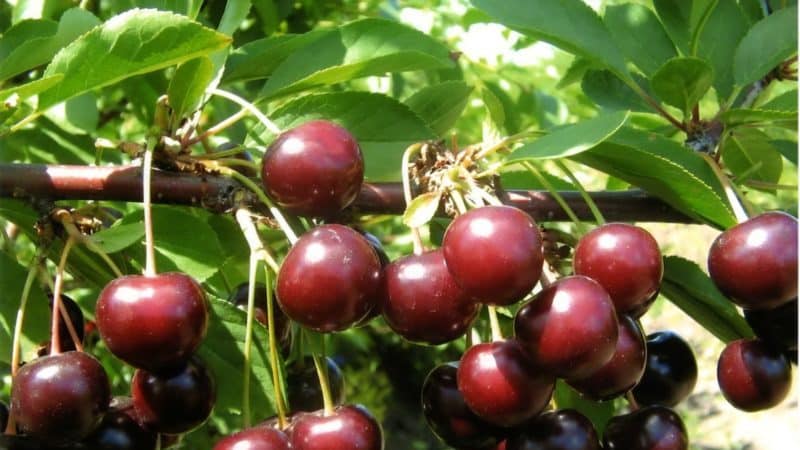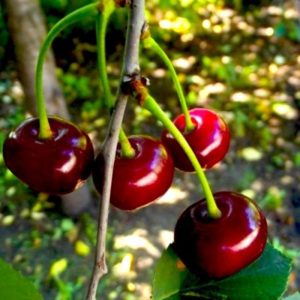Fast-growing resistant cherry variety “Tamaris”
What should the ideal cherry be like? Juicy, sweet, beautiful and fruitful. The Tamaris variety meets all these criteria, and also differs from most other varieties in its attractive compact bushes and beautiful snow-white flowers.
Tamaris cherry has won the love of summer residents due to its easy care and frost resistance. The berries are universal in use - they are eaten fresh straight from the bush, frozen for the winter, or used to make aromatic jam or preserves.
Description and characteristics of the Tamaris cherry variety
Tamaris cherry is the result of the work of Soviet breeders. The berry is intended for cultivation in the Central and North Caucasus region of Russia, as well as in Crimea and the CIS countries. The variety has declared itself as productive, self-fertile and unpretentious in care.
Let's look at the description of the Tamaris cherry variety and its features.

Description of the tree and fruits
Tamaris is a dwarf variety, the height of the tree is no more than 2 m. The crown is medium dense, spreading. The leaves are oblong, oval. The flowers are small and white - the cherry tree looks beautiful during the flowering period. The shoots are long, classic brown in color.
Tamaris is suitable for planting in a small garden plot - the tree takes up little space and is often used as a hedge.
The fruits are round, weight from 3 to 5 g. The peel is glossy, the color is rich red, less often burgundy. The pulp is dense and fleshy, juicy, sweet and sour.The seed is light beige in color, large, and easily separated from the berry. The stalk of the berry is long.
Frost resistance and drought resistance
The variety is winter-hardy and tolerates temperatures down to -25°C. If the temperature is lower, the shoots will freeze slightly, but will quickly recover; this does not affect the yield. Drought resistance is average; with a long absence of moisture, a deterioration in the taste of the fruit is observed. Therefore, it is recommended to monitor soil moisture and water the cherries in a timely manner.
Attention! If cherries are grown in the northern regions, then in the first years after planting the tree is covered with burlap or boards. They protect seedlings from sharp and cold winds, frosts, and snowfalls.
Variety resistance to diseases and pests
Resistance to coccomycosis is high. Coccomycosis is the most dangerous fungal disease of cherries that can destroy the entire crop. Signs are small red-brown marks on the leaf blades, wilting and shedding. If symptoms are not detected in time, the fruits will fall off and the tree will die. To prevent coccomycosis, it is recommended to treat the soil before landing, and soak the roots of the seedling in a solution of potassium permanganate.
Immunity to other diseases is above average, but it is not recommended to forget about preventive measures. Tamaris is rarely affected by insects, especially if you monitor the condition of the tree, feed the plant regularly, weed and loosen the planting site.
Pollinator varieties
The variety is self-fertile - pollinating insects and other cherry varieties are not needed to produce a harvest. However, gardeners advise planting 1-2 pollinating trees nearby to increase productivity. For example, it could be Zhukovskaya cherry.In this case, there is an increase in yield, the berries grow larger and juicier.
Flowering and ripening period
The variety is medium late, ripening begins in late July or early August, depending on the growing region and weather conditions. Before this, the flowering period lasts 5-6 days. The lifespan of the Tamaris cherry is 20 years.
Attention! Subject to agrotechnical rules, gardeners annually collect 10 kg of juicy and ripe cherries from one bush. The variety is not suitable for long-term storage and transportation, so the berries are eaten fresh or processed to make compotes, jellies, jams, and marshmallows.
Advantages and disadvantages
The advantages of the variety include self-fertility, high and stable yield, and frost resistance. Also distinguished taste qualities of fruits, resistance to diseases and pests.
Disadvantages of the variety: drought resistance is average, the fruits are not used for transportation and long-term storage.

Planting seedlings
Cherries are planted in spring or autumn. For the northern regions, spring is preferable - the seedlings will not freeze in the winter, which will have a positive effect on the yield. Tamaris cherry loves light, so choose spacious and sunny garden areas for planting. A windless slope or hill will do.
The tree is not transplanted to another place - it will not survive this procedure. Therefore, the choice of location is taken responsibly.
Cherry prefers a mixture of loamy and sandy loam soils. If the soil is acidic, then before planting, gardeners add a solution based on wood ash - it neutralizes the acidity, makes the soil more suitable, and the seedlings take root faster. When planting several trees at once, it is important to maintain a distance between them - at least 3.5 m.
Instructions for planting Tamaris seedlings
Planting seedlings does not require special knowledge and skills, but it is recommended to follow simple recommendations:
- They prepare the place - remove debris and remains of last year's plants, disinfect the soil with the preparation "HOM" or a solution of Bordeaux mixture.
- A hole measuring 60 cm x 60 cm is dug in the area. The top layer of soil is mixed with humus, superphosphate or ash is added.
- 4 hours before planting, seedlings are soaked in water at room temperature so that the roots are saturated with moisture.
- A seedling is placed in the hole, and a wooden peg is placed next to it. It protects young cherries from strong gusts of wind.
- Sprinkle the base of the seedling with soil and compact it. For the first 2 days, water the plant generously with warm water, mulch with cut grass, hay, leaves and sawdust.
Subtleties of further care
It is impossible to get tasty and juicy berries without proper and regular care. Tamaris cherry needs watering, preventive measures to protect against diseases, weeding and fertilizers.
Watering intensity
Seedlings require moderate watering. In the first 2 years they are watered 4-5 times per season. At a distance of 50 cm from the trunk, gardeners create a ditch 20 cm deep. Water at room temperature is suitable for irrigation; about 13 liters are required for one seedling.
It is not recommended to flood the cherries at once; it is better to mulch the soil - this way the moisture will flow deep to the roots, and will not evaporate at the first opportunity. If the summer turns out to be rainy and humid, then the amount of watering is reduced or not watered at all.
Mature trees are watered with the arrival of spring and after flowering. During the period of fruit ripening, cherries require less moisture - due to an excess, the berries crack.When watering, the root collar is not moistened; after the procedure, the soil is slightly loosened and weeds are removed.
Soil fertilization
Fertilizers strengthen the plant’s immunity, protect it from bacteria and fungi, and make the fruits sweeter and more aromatic. Mineral and organic fertilizers are suitable for Tamaris cherries. Due to a lack of vitamins, cherries stop growing, become weak, and often get sick. However it is important to avoid overfeeding — overfed trees freeze in winter and are sensitive to any weather changes.
Fertilization begins in the second year after planting. Ammonium nitrate, urea, superphosphate, and humus are used. They are introduced into the tree trunk circle or annular grooves. After 5 years (in the seventh year), the amount of applied complexes is reduced. If you fertilize with powdered components, then be sure to water the plant afterwards.
Attention! The recipe for an effective universal fertilizer for a cherry tree is a solution based on chicken manure + 400 g of ammonium nitrate + 500 g of double superphosphate + a layer of peat (per 1 sq.m.).
Pruning and crown formation
Trim the crown in spring, summer or autumn. Long-term trees, productivity, and fruit quality depend on pruning. Gardeners remove all shoots that obscure the crown of the tree. If the length of these shoots is less than 30 cm, then they are not touched. Before winter, the tree should not have branches that extend from the trunk at an acute angle.
When forming the crown, young branches are lifted and tied to stronger shoots. This activates the growth of the plant. To trim cherry seedlings, use a knife or garden saw. It is not recommended to use pruning shears - they can damage a tree that has not yet matured.
Disease and pest control
The Tamaris variety is rarely affected by pests, but no one can guarantee one hundred percent protection against them. Fruit borer mites are found on young seedlings. They eat shoots and leaves and disrupt plant metabolism. For preventive and therapeutic purposes, gardeners spray trees with Fufafon or Fitoverm. The reasons for the appearance of mites are weak immunity, infected seedlings or soil, and improper care.
Another common pest is the cherry aphid. It sucks juice from berries, which is why the fruits grow small and insipid. Aphids overwinter at the base of the buds and become active in early or mid-summer. To combat, use the drug "Kemifos" or spraying with a solution of copper sulfate.
Cherries can also develop moniliosis - a fungal disease accompanied by gray spots on the bark and growths on the leaves and fruits. Deep cracks appear on the shoots. For treatment, spraying with Nitrafen or copper sulfate is used. It is important to regularly carry out preventive measures and monitor the condition of cherry trees.
Harvest and storage

Harvest in dry and windless weather, when there is no moisture on the tree. The plants are not tall - it is easy for gardeners to reach the very top without special tools. Ripeness is determined by appearance - the berries simultaneously acquire a dark red color, become elastic, and the skin shines. It is recommended to harvest the crop with gloves - the pulp contains acid, due to which the delicate skin of the hands and nails are subject to burns.
If the fruits sit weakly on the branch, then when one berry is picked, the rest fall to the ground. In this case, gardeners spread a piece of dense polyethylene on the ground in advance.For collection, use a clean garden bucket, bottles, or other plastic container.
Attention! Gardeners have differing opinions. Some believe that cherries should be picked along with the stem to increase the shelf life of the berry. Others argue that tearing off the stem negatively affects the future harvest, and it is important to pick the cherries using scissors, cutting off only half of the stem.
Tamaris cherries are not suitable for long-term fresh storage. Winter preparations are prepared from the harvest or the berries are eaten just like that. Housewives also freeze the fruits for the winter in the freezer - they wash, dry and remove the seeds. Frozen cherries are added to desserts, drinks and baked goods, ground with sugar and served with tea.
Reviews from gardeners
In general, gardeners are satisfied with the yield and varietal qualities of Tamaris cherries.
Alexandra, St. Petersburg: “The Tamaris variety is my favorite! The berry is unpretentious, the taste is 5 points. And what beautiful trees grow - a living decoration for my garden. During my cultivation, I never encountered any diseases, only once did a spider mite appear, but I quickly got rid of it.”
Vladimir, Moscow region: “Tamaris is a good variety. Fruits in the third year, the trees are small. The berries are of average taste, the yield is stable. Last year I collected 7 kg from a tree. I simply care for cherries - I water them, feed them with manure and ash, and mulch them. Once a year I form the crown.”
Conclusion
The Tamaris variety is grown in the south, in the Central zone, in the north-west of Russia. Seedlings are planted in spring or autumn, and a spacious and sunny place is prepared in advance. The distance between seedlings is at least 3.5 m. The berries are medium-sized, round, dark red or burgundy in color.The pulp is sweet and sour, pleasant.
Tamaris rarely gets sick; it is frost-resistant and immune to the most common diseases of berry crops. The height of an adult tree is no more than 2 m, so a stepladder or ladder is not required to pick berries. The fruits are not suitable for long-term storage; it is recommended to use them immediately after harvest.